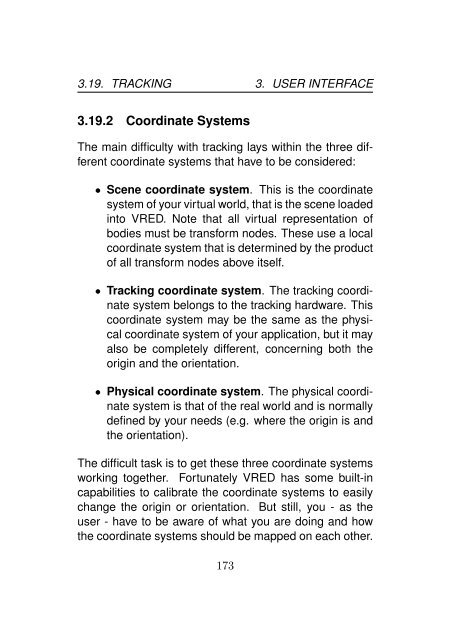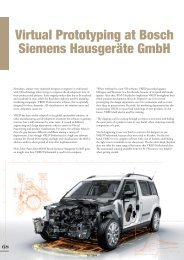VRED - Virtual Reality Editor - PI-VR GmbH
VRED - Virtual Reality Editor - PI-VR GmbH
VRED - Virtual Reality Editor - PI-VR GmbH
You also want an ePaper? Increase the reach of your titles
YUMPU automatically turns print PDFs into web optimized ePapers that Google loves.
3.19. TRACKING 3. USER INTERFACE<br />
3.19.2 Coordinate Systems<br />
The main difficulty with tracking lays within the three different<br />
coordinate systems that have to be considered:<br />
• Scene coordinate system. This is the coordinate<br />
system of your virtual world, that is the scene loaded<br />
into <strong><strong>VR</strong>ED</strong>. Note that all virtual representation of<br />
bodies must be transform nodes. These use a local<br />
coordinate system that is determined by the product<br />
of all transform nodes above itself.<br />
• Tracking coordinate system. The tracking coordinate<br />
system belongs to the tracking hardware. This<br />
coordinate system may be the same as the physical<br />
coordinate system of your application, but it may<br />
also be completely different, concerning both the<br />
origin and the orientation.<br />
• Physical coordinate system. The physical coordinate<br />
system is that of the real world and is normally<br />
defined by your needs (e.g. where the origin is and<br />
the orientation).<br />
The difficult task is to get these three coordinate systems<br />
working together. Fortunately <strong><strong>VR</strong>ED</strong> has some built-in<br />
capabilities to calibrate the coordinate systems to easily<br />
change the origin or orientation. But still, you - as the<br />
user - have to be aware of what you are doing and how<br />
the coordinate systems should be mapped on each other.<br />
173










